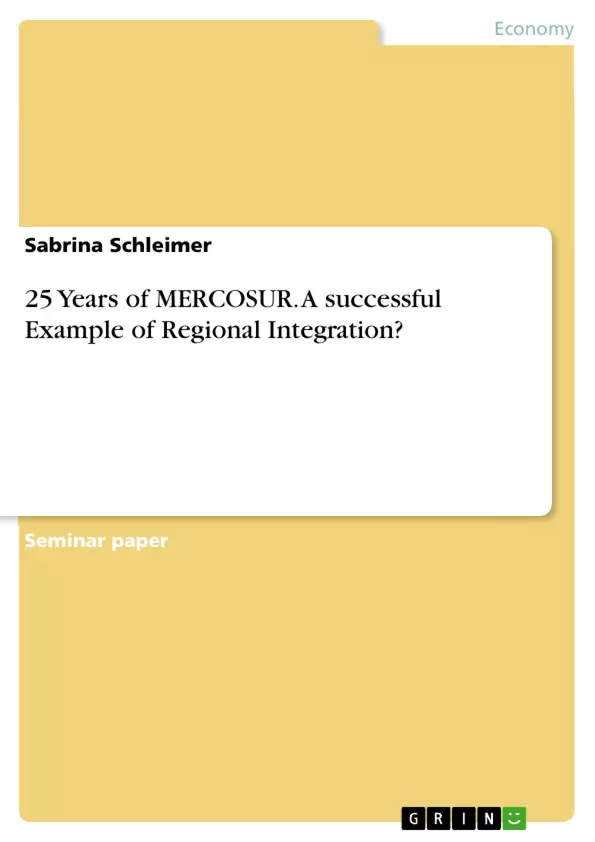The following extended term paper will analyse MERCOSUR and examine whether it can be regarded as a successful example of regional integration. To do so, the paper will review the objectives set in the founding treaty, the Treaty of Asunción, and analyse whether they have been fully met. At a glance, the objectives of MERCOSUR were to “eliminate trade barriers, establish a common external tariff, coordinate macroeconomic policies and develop the harmonization of laws” (Arieti, 2006, p. 764). To fulfil these objectives, the development of MERCOSUR was supposed to go through three gradual stages: the first goal was to create a free trade area, this was to be followed by a customs union, and the third and final aim was the creation of a common market. These stages will be analysed to conclude if they have been reached. At the same time, the main achievements and challenges of MERCOSUR’s integration experience will be presented.
The limited scope of this term paper does not allow for an analysis of every aspect in great detail. Due to this, the main focus after the theoretical section will be on the area of trade and on the earlier stages of the agreement, as this is most important to establish the success of MERCOSUR as a regional trade agreement and thus highly relevant to find an answer to the research question.
In the era of globalisation, international markets have continued to grow in importance. Many regional economic integration agreements have been negotiated and created to improve competitiveness in global trade. One of these regional agreements is the ‘Mercado Común del Sur’ (MERCOSUR), in English ‘Common Market of the Southern Cone’, which was founded by Argentina, Brazil, Paraguay and Uruguay in 1991. Its creation was expected to mark an economic transition of the region as “the conditions for economic expansion were viewed as highly favourable” (ASEAN Studies Centre, 2009, p. 10). 2016 marks the 25th anniversary of MERCOSUR and the regional trade agreement has grown to a significant size over the past years. It is the largest integration agreement in Latin America and the Caribbean, the fourth largest in the world and the fifth biggest economy in the world (MERCOSUR, 2017b). It encompasses around 260 million citizens and had a combined GDP of more than 2.8 trillion USD in 2015 (Campbell, 2015).
Inhaltsverzeichnis (Table of Contents)
- 1. Introduction
- 2. Underlying Theoretical Concepts
- 2.1 Internationalisation and Globalisation
- 2.2 Regional Economic Integration
- 3. Introduction to MERCOSUR
- 3.1 Founding
- 3.2 Objectives
- 3.3 Structure
- 4. Developments
- 4.1 Trade
- 4.1.1 Internal Trade
- 4.1.2 External Trade
- 4.2 Economics
- 4.2.1 GDP Evolution
- 4.2.2 Monetary Developments
- 4.3 Democracy
- 4.1 Trade
- 5. Conclusion
Zielsetzung und Themenschwerpunkte (Objectives and Key Themes)
This paper analyzes the progress of MERCOSUR, a regional integration project in South America, over the past 25 years. It examines the theoretical framework of regional economic integration, the specific objectives and structure of MERCOSUR, and its developments in trade, economics, and democracy. The paper aims to evaluate the success of MERCOSUR in achieving its goals and to identify key factors contributing to its progress or challenges.
- Regional Economic Integration Theory
- MERCOSUR's Objectives and Structure
- Trade Developments within MERCOSUR
- Economic Performance of MERCOSUR Member States
- Democracy and Political Integration in MERCOSUR
Zusammenfassung der Kapitel (Chapter Summaries)
The introduction provides an overview of the topic and sets the context for the analysis. Chapter 2 explores the theoretical concepts of internationalization, globalization, and regional economic integration, providing a framework for understanding MERCOSUR's objectives and challenges. Chapter 3 introduces MERCOSUR, detailing its founding, objectives, and structure. Chapter 4 examines the developments in MERCOSUR, including trade, economic performance, and democratic processes.
Schlüsselwörter (Keywords)
MERCOSUR, regional economic integration, trade liberalization, economic growth, democracy, South America, internationalization, globalization, free trade area, customs union, common market, economic union, supranational union, GDP, foreign direct investment, non-tariff barriers.
- Quote paper
- Sabrina Schleimer (Author), 2017, 25 Years of MERCOSUR. A successful Example of Regional Integration?, Munich, GRIN Verlag, https://www.grin.com/document/369458



